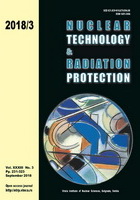
DERIVATION OF A SPECIIC ACTIVITY LIMIT FOR PLUTONIUM FOR NEAR SURFACE DISPOSAL A Case Study at a Potential Site in Northwest China

Vol.
XXXIII, No. 3, Pp. 231-323
September 2018
UDC 621.039+614.876:504.06
ISSN 1451-3994
Pages: 307-316
Authors: Dong-Xu Liu, Xiao-Wei Xiong, Jin-Sheng Wang, Li-Tang Hu, and Rui ZuoAbstract
Based on the safety assessment framework and site-specific characteristic investigations in northwest China, an approach to deriving the specific activity limit of 239Pu is applied to establish a proposed value. Our analyses, in conjunction with the results of other previous studies, allow for the following conclusions: (1) As an intrusion scenario with a feature of minimal site-dependence and pervasive applicability, the drilling scenario can be used as the limiting scenario for the post-closure period; (2) Given a dose limit of 5 mSv per year, a derived specific activity of 287 Bqg-1 (at a disposal depth shallower than 5 m) for 239Pu is obtained through the formulation of models and subsequent calculations. It is suggested that both our approaches to deriving the limit and the results can be effectively applied to establish acceptance criteria of long-lived transuranic nuclides, for the particular disposal facility; and (3) From the standpoint of exploring the approach for limit derivation, the intrusion scenario and the corresponding exposure evaluation can be the focus of concern in the study area. It is implied that, in arid regions, a leaching scenario may lead to a more complex evaluation, with unnecessary effort, and can be virtually excluded.
Key words: near surface disposal, safety assessment, plutonium, derivation of limit
FULL PAPER IN PDF FORMAT (353 KB)